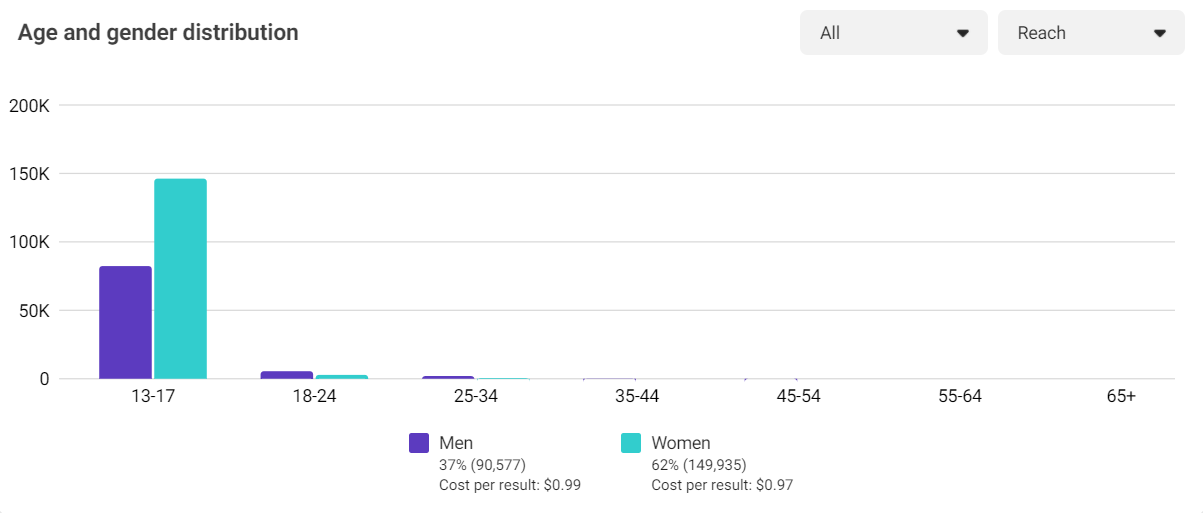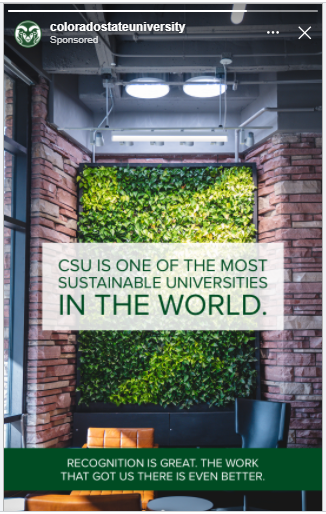Colorado State University is a national leader in the sustainability space. We are the only higher education institution to earn the STARS sustainability platinum rating three times. We chose to highlight this theme in a micro social media ad campaign that we kicked-off during Earth Week in April.
The objective
Being absolutely clear with an objective is critical for the success of a digital ad campaign. Our campaign objective was to build awareness of CSU’s leadership in the sustainability space and achieve top and middle-of-the-funnel goals – Reach and Website Clicks. Our campaign was focused on a broad national audience already invested in sustainability.
Laying the groundwork
Creating a successful digital campaign requires collaboration. From refining the ad copy to selecting the ideal landing page, taking input from various stakeholders is crucial, especially in a higher education marketing setting.
Choosing the channels to prioritize our ad spend was important, too. After a couple of brainstorm sessions, our team decided that the bulk of our ad spend should go toward Instagram, followed by Twitter. Instagram is the place where a significant portion of our younger audience resides, and Twitter is the place where some of our most engaged students and alumni live. Instagram accounted for more than 50% of our total ad spend.
The team chose CSU’s sustainability website as the landing page for the campaign. Various pillars of CSU’s sustainability efforts and the accolades received over the years are listed on this page, so it felt like a natural fit.
Ad copies + assets
We deliberately and strategically crafted the ad assets to showcase the university’s brand personality that can be seen through CSU’s desire to care for the environment, and highlighted CSU’s commitment to sustainability in everything it does. You can observe the elements of these brand personality attributes in the ad copies, images and audience targeting.
CSU is the only higher education institution to earn STARS Platinum #sustainability rating three times.
Recognition is great. The work that got us there is even better.
— Colorado State University (@ColoradoStateU) April 21, 2021
Our Twitter carousel images featured text-on-images to help contextualize the ads. Based on our prior research, we also decided to not include text-overlay on images for Instagram as it does not seem to work that well!
We also ran Instagram Story ads and it was a huge success. IG Stories are an immersive ad experience. We found that to be the case, observing higher click through for Story Ads in our ‘Traffic Campaign.’
Following is a snapshot of our Instagram Story ad:
Our Instagram guru, Ashley Schroeder created the cool story ad above. In fact, she offers some easy Instagram Story tips in this blog post.
Instagram Results
We drove two campaigns on Instagram with slightly different objectives:
- A Reach campaign geared toward showing the ad to the maximum number of people. The campaign reached 410K people, and earned 152 link clicks.
- A Traffic campaign for optimizing clicks to the website. The campaign reached 337K people, and earned 942 link clicks.
We started off with the Traffic-type campaign, but pivoted to a Reach-type campaign toward the end. Both the campaign types had the same ad copy, images and age group targeting. One key difference between the two was including the Interest Group ‘Student’ for our Reach campaign. This enabled us to reach a large number of prospective students (aged 16 -18), minimizing the overlap between the sets of people who saw the two campaigns.
Twitter Results
We used a total of three ad groups, each with slightly different audience targeting and ad copies. For two of our ad groups we used audience lookalike targeting, and they were targeted toward a Colorado audience.
For the third ad group, we used the keyword targeting feature to deliver our ads where keywords such as sustainability, #sustainable, #ecofriendly, #cleanenergy, environment, renewable energy, #sustainability featured in conversations.
We had a lot more success with the ad group based on keyword targeting, which had a whopping 7.95% link click rate.
The Twitter campaign earned a total of 53.2K impressions and 3,322 link clicks.
Learnings
- If you are planning to run Twitter Ads categorized as cause-based (as our Earth Week campaign was), you will need to go through an approval process with Twitter. You will need to submit a form to get certified as a cause-based advertiser.
- Carousels have had the highest engagement among media types for us. This was evident from our previous campaigns, too, where carousel ads far outshone the single image ads. We have not tried out the video ads yet, so I don’t have any numbers on their efficacy.
- Twitter Ads perform really well when using a ‘Website Traffic’ type campaign. Even though, we’ve observed low Impressions on Twitter, our cost-per-click was way below the Twitter average.
- Instagram Ads performed best in the ‘Reach’-type campaign. This campaign type is highly recommended for top/middle of the funnel results – Reach/Impressions and Link Clicks.
- Adding the audience group ‘Students’ in Instagram targeting proved to be a great success in reaching potential prospective students.

- Both Instagram and Twitter ‘learn’ about a campaign’s targeting for the first 24 hours. It is recommended to start with a smaller daily budget to give the platform some time to learn how to best serve your ads.
- It is ideal to duplicate the campaigns before making any sweeping changes to Facebook/Instagram ad sets so that your campaigns don’t go into the ‘learn’ phase again.
